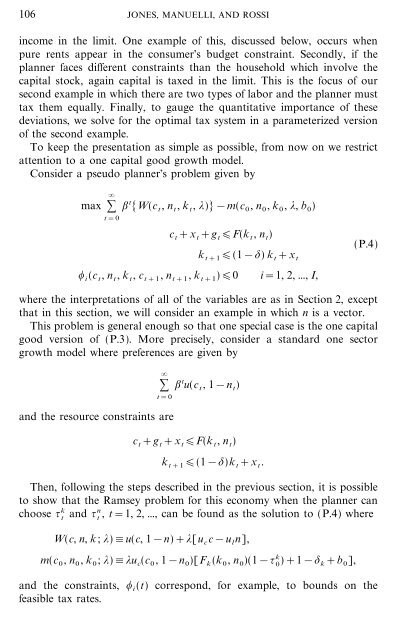On the Optimal Taxation of Capital Income
On the Optimal Taxation of Capital Income
On the Optimal Taxation of Capital Income
Create successful ePaper yourself
Turn your PDF publications into a flip-book with our unique Google optimized e-Paper software.
106 JONES, MANUELLI, AND ROSSI<br />
income in <strong>the</strong> limit. <strong>On</strong>e example <strong>of</strong> this, discussed below, occurs when<br />
pure rents appear in <strong>the</strong> consumer's budget constraint. Secondly, if <strong>the</strong><br />
planner faces different constraints than <strong>the</strong> household which involve <strong>the</strong><br />
capital stock, again capital is taxed in <strong>the</strong> limit. This is <strong>the</strong> focus <strong>of</strong> our<br />
second example in which <strong>the</strong>re are two types <strong>of</strong> labor and <strong>the</strong> planner must<br />
tax <strong>the</strong>m equally. Finally, to gauge <strong>the</strong> quantitative importance <strong>of</strong> <strong>the</strong>se<br />
deviations, we solve for <strong>the</strong> optimal tax system in a parameterized version<br />
<strong>of</strong> <strong>the</strong> second example.<br />
To keep <strong>the</strong> presentation as simple as possible, from now on we restrict<br />
attention to a one capital good growth model.<br />
Consider a pseudo planner's problem given by<br />
max :<br />
t=0<br />
; t [W(c t, n t, k t, *)]&m(c 0, n 0, k 0, *, b 0)<br />
c t+x t+g t<br />
k t+1<br />
F(k t, n t)<br />
(1&$) k t+x t<br />
, i(c t, n t, k t, c t+1, n t+1, k t+1) 0 i=1, 2, ..., I,<br />
(P.4)<br />
where <strong>the</strong> interpretations <strong>of</strong> all <strong>of</strong> <strong>the</strong> variables are as in Section 2, except<br />
that in this section, we will consider an example in which n is a vector.<br />
This problem is general enough so that one special case is <strong>the</strong> one capital<br />
good version <strong>of</strong> (P.3). More precisely, consider a standard one sector<br />
growth model where preferences are given by<br />
:<br />
t=0<br />
and <strong>the</strong> resource constraints are<br />
c t+g t+x t<br />
k t+1<br />
; t u(c t,1&n t)<br />
F(k t, n t)<br />
(1&$)k t+x t.<br />
Then, following <strong>the</strong> steps described in <strong>the</strong> previous section, it is possible<br />
to show that <strong>the</strong> Ramsey problem for this economy when <strong>the</strong> planner can<br />
choose { k<br />
t and {n<br />
t , t=1, 2, ..., can be found as <strong>the</strong> solution to (P.4) where<br />
W(c, n, k; *)#u(c, 1&n)+*[u cc&u ln],<br />
m(c 0, n 0, k 0; *)#*u c(c 0,1&n 0)[F k(k 0, n 0)(1&{ k<br />
0 )+1&$ k+b 0],<br />
and <strong>the</strong> constraints, , i(t) correspond, for example, to bounds on <strong>the</strong><br />
feasible tax rates.
















